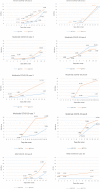Antibody response and the clinical presentation of patients with COVID-19 in Croatia: the importance of a two-step testing approach
- PMID: 32886230
- PMCID: PMC7472404
- DOI: 10.1007/s10096-020-04019-y
Antibody response and the clinical presentation of patients with COVID-19 in Croatia: the importance of a two-step testing approach
Abstract
According to anti-SARS-CoV-2 seroresponse in patients with COVID-19 from Croatia, we emphasised the issue of different serological tests and need for combining diagnostic methods for COVID-19 diagnosis. Anti-SARS-CoV-2 IgA and IgG ELISA and IgM/IgG immunochromatographic assay (ICA) were used for testing 60 sera from 21 patients (6 with severe, 10 moderate, and 5 with mild disease). The main clinical, demographic, and haemato-biochemical data were analysed. The most common symptoms were cough (95.2%), fever (90.5%), and fatigue and shortness of breath (42.9%). Pulmonary opacities showed 76.2% of patients. Within the first 7 days of illness, seropositivity for ELISA IgA and IgG was 42.9% and 7.1%, and for ICA IgM and IgG 25% and 10.7%, respectively. From day 8 after onset, ELISA IgA and IgG seropositivity was 90.6% and 68.8%, and for ICA IgM and IgG 84.4% and 75%, respectively. In general, sensitivity for ELISA IgA and IgG was 68.3% and 40%, and for ICA IgM and IgG 56.7% and 45.0%, respectively. The anti-SARS-CoV-2 antibody distributions by each method were statistically different (ICA IgM vs. IgG, p = 0.016; ELISA IgG vs. IgA, p < 0.001). Antibody response in COVID-19 varies and depends on the time the serum is taken, on the severity of disease, and on the type of test used. IgM and IgA antibodies as early-stage disease markers are comparable, although they cannot replace each other. Simultaneous IgM/IgG/IgA anti-SARS-CoV-2 antibody testing followed by the confirmation of positive findings with another test in a two-tier testing is recommended.
Keywords: Anti-SARS-CoV-2 antibody response; COVID-19 diagnostics; Clinical and laboratory findings; Croatia; Serological methods; Two-step testing approach.
Conflict of interest statement
The authors declare that they have no conflict of interest.
Figures


References
-
- No Title [Internet]. Available from: https://www.hzjz.hr/priopcenja-mediji/koronavirus-najnoviji-podatci/
MeSH terms
Substances
LinkOut - more resources
Full Text Sources
Medical
Miscellaneous

